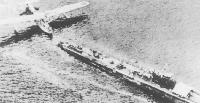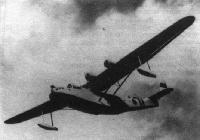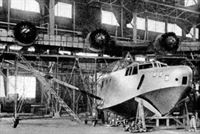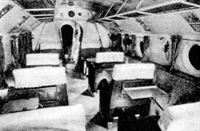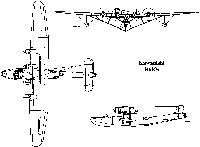
Описание
Страна : Япония
Год : 1936
Летающая лодка
Летающая лодка-дальний морской разведчик/бомбардировщик
H6K
Летающая лодка, четырехмоторный цельнометаллический моноплан-парасоль с двухкилевым оперением. Создан в КБ фирмы "Каваниси кокуки" под руководством С. Кикухары. Опытный образец машины, лодка "тип S", впервые поднялась в небо 14 июля 1936 г. Серийное производство Н6К наладили на заводе "Каваниси" в Наруо в сентябре 1938 г. Всего построено 215 экз. (по другим данным - 217 экз.), включая транспортные и пассажирские варианты.
Экипаж - 8-9 чел. Двигатели и вооружение - в зависимости от модификации.
Н6К был принят на вооружение японской морской авиации во время войсковых испытаний, в середине 1937 г., как "тип 97".
Основные серийные модификации:
- H6K1, доработка опытных самолетов под моторы "Хикари" 43, вооружение 3x7,69, бомбы до 1600 кг или две торпеды;
- H6K2 с усовершенствованным оборудованием;
- H6K2-L - пассажирский (военно-транспортный) вариант H6K2 без вооружения;
- Н6КЗ - штабной самолет на базе H6K2;
- H6K4 с моторами "Хикари" 43 (с августа 1941 г-"Кинсей" 46), первая массовая модификация, введены бортовые блистеры, удлиненная хвостовая часть, снята верхняя турель, вооружение 1x20+4x7,69;
- H6K4-L с моторами "Кинсей" 46, военно-транспортный самолет без вооружения на базе H6K4;
- H6K5 с моторами "Кинсей" 51, вооружение 1x20+4x7,69 (введена турель над пилотской кабиной), с конца 1942 г. монтировалась РЛС.
В начале войны Н6К базировались в Японии, на Маршалловых и Каролинских о-вах. Начали боевые действия налетом на о. Уэйк 11 декабря 1941 г. Участвовали в захвате Филиппин и Индонезии.
31 декабря потопили авиатендер "Герон". С января 1942 г осуществляли систематические налеты на Рабаул, 20 февраля они обнаружили перед началом сражения американские корабли в Коралловом море. С апреля 1942 г. начали патрулирование Индийского океана. Занимались дальней разведкой, сопровождением конвоев, поиском подводных лодок, наносили бомбовые удары, вели спасательные работы.
С начала 1944 г. старые модификации переделывались для транспортных целей. Последняя крупная операция с участием Н6К - оборона Тайваня в октябре 1944 г.
Н6К сняли с производства в начале 1942 г., с вооружения их стали снимать с начала 1944 г. и полностью убрали из строевых частей к апрелю 1945 г.
H6K4||
Размах:||40,0 м
Длина:||25,63 м
Моторы, количество х мощность:||4x1200 л.с.
Взлетная масса, максимальная:||23000 кг
Максимальная скорость:||340 км/ч
Практический потолок:||6500 м
Дальность:||6100 км
Описание:
- H6K
- Kawanishi H6K "Mavis"
Фотографии
-
АвиаМастер 2003-05 / А.Казымов - Соломоновы острова: хроника противостояния /Из истории воздушных войн/ (1)
Четырехмоторная летающая лодка H6K4 "Мэвис" из состава авиагруппы "Иокогама" японских Императорских ВМС.
-
Мировая Авиация 164
На рисунке - вариант H6K5. Самолеты "Mavis" лучше всего подходили на роль дальнего морского разведчика, правда, если рядом не было истребителей противника.
-
Air International 1985-12 / ??? - Kawanishi's Parasol Patroller /Warbirds/
Экспериментальная военно-морская летающая лодка 9-Shi стала прототипом H6K. ВМС Японии требовалась лодка, превосходившая по летным данным американскую Sikorsky S-42.
The Navy Experimental 9-Shi Flying Boat, the prototype of the H6K series, this, together with the third and fourth prototypes, eventually being re-engined and entering service as the H6K1. -
АвиаМастер 2003-06 / А.Казымов - Соломоновы острова: хроника противостояния /Из истории воздушных войн/ (2)
Четырехмоторная летающая лодка H6K-4 "Мэвис" - стратегический воздушный разведчик японского флота.
-
Jane's All the World Aircraft 1980 / Encyclopedia of Aviation - Aircraft A-Z - v4
В битве за Алеуты японцы потеряли 6 летающих лодок H6K4 "Мейвис"
Kawanishi Navy H6K4. -
Авиация и Время 2008-01 / В.Заблоцкий, А.Овчаренко - Австралийский Перл-Харбор (1)
Японская летающая лодка "Каваниши" H6K заправляется от подводной лодки
-
АвиаМастер 2003-05 / А.Казымов - Соломоновы острова: хроника противостояния /Из истории воздушных войн/ (1)
Японские морские разведчики F1M2 "Пит" и H6K4 "Мэвис" у острова Шортленд.
Другие самолёты на фотографии: Mitsubishi F1M - Япония - 1936
-
Моделист-Конструктор Гидросамолеты Второй мировой войны
H6K4 с моторами "Хикари"
-
Мировая Авиация 215
Летающая лодка H6K обладала большой продолжительностью полета, за счет чего могла выполнять длительные патрульные полеты над Тихим океаном. Дальность полета финального варианта H6K5 составляла 6772 км.
-
Air International 1985-12 / ??? - Kawanishi's Parasol Patroller /Warbirds/
The H6K5, or Type 97 Flying Boat Model 23, was built as a safeguard against delays in service deliveries of the very much more advanced Type 2 Flying Boat, being used by both the Tokoh and Yokohama Kokutais, and their successors, the 801st and 851st Kokutais.
-
Air International 1985-12 / ??? - Kawanishi's Parasol Patroller /Warbirds/
A newly completed H6K5 flying boat. Note the offset gun turret above the flight deck housing a 7,7-mm Type 92 machine gun.
-
Air International 1985-12 / ??? - Kawanishi's Parasol Patroller /Warbirds/
An H6K5 photographed over the Marshall Islands from another 'boat of this type. Note the Type 91-3 torpedo on the rack spanning the bracing struts in the foreground.
-
Air International 1985-12 / ??? - Kawanishi's Parasol Patroller /Warbirds/
Kawanishi H6K был чрезвычайно элегантным самолетом, по своему назначению сопоставимым с американской летающей лодкой PBY Catalina. Результаты испытаний H6K признали удовлетворительными, хотя мощность силовой установки была недостаточной.
H6K5 flying boats of the Yokohama Kokutai, these being the last production variant of the Type 97 'boat -
Air International 1985-12 / ??? - Kawanishi's Parasol Patroller /Warbirds/
H6K4-L transport flying boats from the Yokosuka Naval Base photographed at Ambon, Netherlands East Indies, in 1943.
-
Air International 1985-12 / ??? - Kawanishi's Parasol Patroller /Warbirds/
An H6K2-L transport flying boat displaying the markings of the Air Technical Intelligence Unit after the end of hostilities
-
Aviation Historian 30 / P.Vabre - From Flying to Spying (1)
Регистрационный номер: J-BFOY [2] Kawanishi H6K2-L, with Japanese civil registration J-BFOY and named Sazanami, in Dili harbour during the third Japanese proving flight to Portuguese Timor in January 1941. The type was virtually unknown beyond Asia at the time, and it is likely that Ivan Hodder’s photographs of what would soon become an important enemy aircraft revealed the first evidence of its existence to the intelligence services of the British Empire.
-
Air International 1985-12 / ??? - Kawanishi's Parasol Patroller /Warbirds/
10 августа 1945 г. мл. л-т Коршунов заявил о сбитии в районе северокорейского порта Расин японской четырехмоторной летающей лодки H6K
H6K4-L transport flying boats from the Yokosuka Naval Base photographed at Ambon, Netherlands East Indies, in 1943. Twenty H6K4-Ls were built, two others resulting from the conversion of H6K4 maritime patrol bombers, and several of these were assigned to Dai Nippon. -
Aviation Historian 31 / P.Vabre - From Flying to Spying (2)
Регистрационный номер: J-BFOY [2] With the tropical-rainforested mountains rising in the background, Kawanishi H6K2-L J-BFOY, named Sazanami, of Dai Nippon Koku KK (Imperial Japanese Airways), bobs in Dili harbour during the third Japanese proving flight to Portuguese Timor in January 1941. At right in the distance is the tender Neishi Maru, sent from Palau in support.
-
Aviation Historian 40 / E.Young - To the south seas and beyond
An H6K2 of Dai Nippon Koku taxies with its two outboard engines running. The men on the port wing are probably the two mechanics taken on every flight as part of the crew. The H6K2-L’s Mitsubishi Kinsei engines were extremely reliable and it was one of the best aero-engines to be produced by the Japanese during the period.
-
Aviation Historian 40 / E.Young - To the south seas and beyond
Регистрационный номер: J-BFOZ One of the early H6K2-Ls, J-BFOZ Ayanami, is inspected by officials before a flight to the South Seas. In Dai Nippon Koku service the flying-boats incorporated the Hinomaru (sun) symbol on the fuselage aft of the parasol wing, with the registration aft of that and the letter J (for Japan) on the inner and outer sides of the rudders.
-
Aviation Historian 40 / E.Young - To the south seas and beyond
Another image from the August 1941 issue of Koku Asahi showing a Dai Nippon Koku H6K2 being prepared for a flight on the Japan-Saipan-Palau service at the airline’s base at Yokohama in Tokyo Bay. After Japan’s entry into the Second World War in late 1941, the military Type 97s were given the Allied codename Mavis.
-
Aviation Historian 40 / E.Young - To the south seas and beyond
A poor-quality but extremely rare image scanned from the pages of the March 1943 issue of Japanese monthly magazine Koku Asahi showing a Kawanishi Type 97 under construction at Naruo.
-
Air International 1985-12 / ??? - Kawanishi's Parasol Patroller /Warbirds/
An H6K2-L transport flying boat expropriated by Indonesian forces and photographed at Surabaya, Java, after capture by the Dutch. Note the blue segment added by the Dutch to the Indonesian red and white fuselage marking aft of the surrender cross.
-
Aviation Historian 40 / E.Young - To the south seas and beyond
LEFT Dai Nippon Koku aircrew certainly earned their pay; a pilot and copilot would fly the entire flight from Japan to Saipan, rest for a day or two, then fly on to Palau before making the return flight. RIGHT Every flight to the South Seas carried two radiomen who were in constant touch with the airline’s stations along the route.
-
Aviation Historian 40 / E.Young - To the south seas and beyond
LEFT Dai Nippon Koku’s H6K2-Ls were equipped with two passenger compartments, the forward compartment seating seven passengers in large comfortable seats, as this image from the August 1941 issue of Koku Asahi shows.
RIGHT For night flights the forward cabin was reconfigured to accommodate four beds. -
Aviation Historian 40 / E.Young - To the south seas and beyond
The rear compartment of the H6K2-L had ten seats for passengers, with tray tables set into the rear of each.
-
Мировая Авиация 215
Подожженная в бою с американскими истребителями японская летающая лодка H6K5 "Мэвис".
Опыт показал чрезвычайную уязвимость H6K от атак истребителей союзников, поскольку лодка не имела ни бронирования, ни протектированных топливных баков. -
Aviation Historian 30 / P.Vabre - From Flying to Spying (1)
During its December 1940 visit to Dili, the DCA working party was shown this splendid metal model of a Kawanishi H6K2-L, the type that completed the Japanese proving flights to Dili during late 1940 and early 1941. The model, photographed by the DCA party, had been presented as a gift to the Governor of Portuguese Timor.
-
Air International 1985-12 / ??? - Kawanishi's Parasol Patroller /Warbirds/
Kawanishi (H6K4) Type 97 Flying Boat Model 22
-
Jane's All the World Aircraft 1946 / 03 - All the world's aeroplanes
The Kawanishi "Mavis" 23 Flying-boat.
-
Моделист-Конструктор Гидросамолеты Второй мировой войны
Kawanishi H6K5
-
Мировая Авиация 164
Kawanishi H6K5 'Mavis'
- Фотографии





